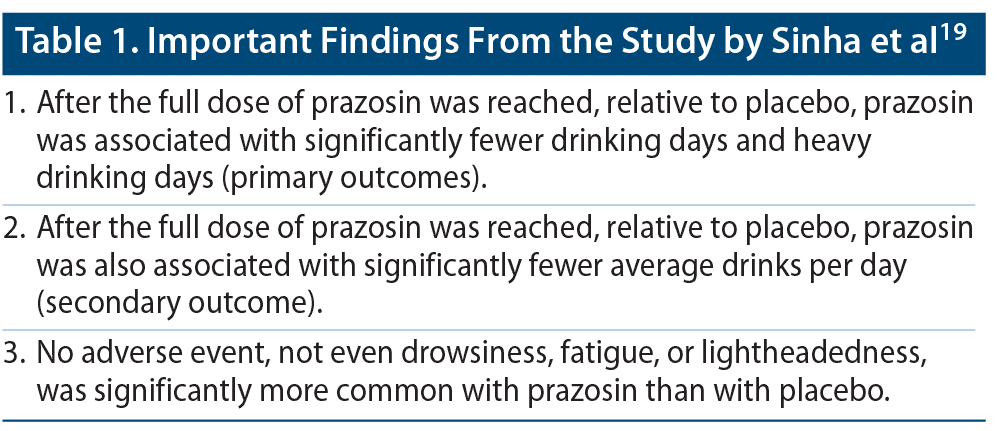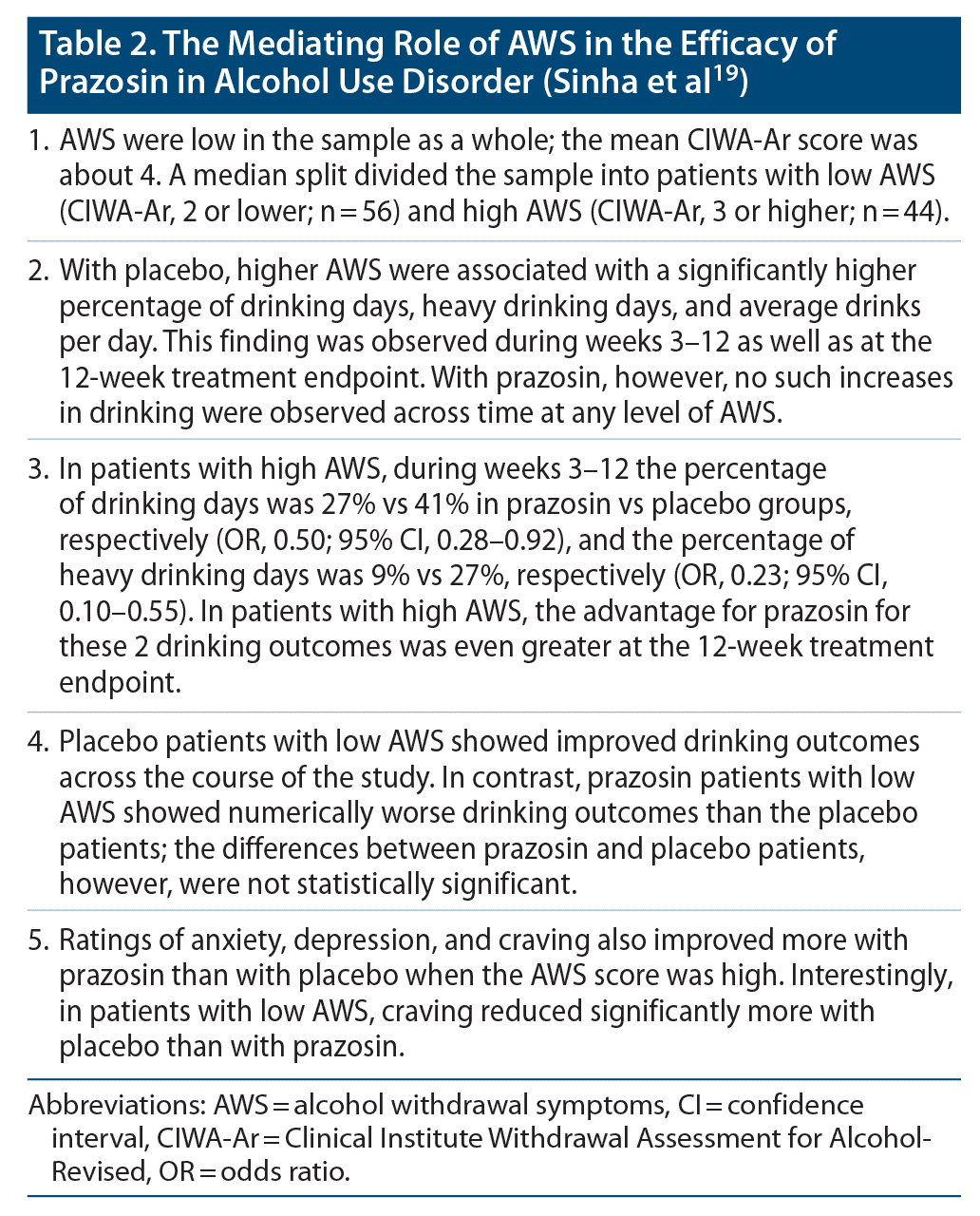ABSTRACT
The choice from among approved treatments for relapse prevention in alcohol use disorder (AUD) is not symptom-driven. It is reasonable to speculate that the discomfort and distress associated with the experience of alcohol withdrawal symptoms (AWS) discourage abstinence and prompt continuation of or relapse into drinking. Adrenergic mechanisms may underlie many of the commonly experienced AWS. This allows the further speculation that drugs with antiadrenergic properties may attenuate AWS and thereby improve treatment outcomes in patients with AUD who attempt to quit drinking. In this context, the α1 adrenoceptor antagonist prazosin is a possible symptom-driven choice for patients with AUD who experience high AWS. Randomized controlled trial (RCT) results with prazosin and doxazosin have however been mixed, perhaps because the role of AWS was not considered in these. In this context, a recent large (n = 100) RCT found that prazosin, uptitrated to 16 mg/d, reduced drinking days, heavy drinking days, and average drinks per day; the benefits were observed only in patients with high AWS at baseline, operationalized as a Clinical Institute Withdrawal Assessment for Alcohol-Revised score of 3 or higher. Concerns about the internal and external validity of this study are discussed. How and when high AWS is determined is also a point of debate. If high AWS is a valid target for the symptom-driven choice of pharmacologic intervention for AUD, then a wide range of drugs merits study; in the long run, some of these drugs may be better tolerated than prazosin.
J Clin Psychiatry 2021;82(2):21f13980
To cite: Andrade C. Prazosin for alcohol use disorder: a symptom-driven approach to the choice of intervention. J Clin Psychiatry. 2021;82(2):21f13980.
To share: https://doi.org/10.4088/JCP.21f13980
© Copyright 2021 Physicians Postgraduate Press, Inc.
In everyday clinical practice, psychiatrists choose drugs that have actions (or side effects) that address the symptom profile that their patients exhibit. For example, mirtazapine, which has a sedating action, may be selected for depressed patients who have severe insomnia. Duloxetine, which is therapeutic in patients with chronic pain syndromes, may be prescribed to a depressed patient with painful diabetic peripheral neuropathy. No similar practice currently characterizes the long-term pharmacologic management of alcohol use disorder (AUD).
In most parts of the world, 3 important drugs are approved for preventing or reducing drinking in alcohol-dependent patients: disulfiram, naltrexone, and acamprosate. Disulfiram deters patients from drinking because patients fear the unpleasant and potentially fatal experience of the alcohol-disulfiram interaction.1 Naltrexone reduces cue-induced craving and the reinforcing effects of alcohol.2,3 Acamprosate is suggested to have anticraving action but, perhaps, is more likely to act by decreasing clinical or subclinical arousal, anxiety, and insomnia that persist beyond alcohol detoxification and that can trigger relapse into drinking.4,5
Other drugs have also been found effective in the intermediate- or long-term management of AUD. Topiramate, for example, is suggested to reduce problem drinking and may have particular benefits in patients with drinking obsessions and automaticity of drinking.6,7 As discussed in an earlier article in this column,8 high-dose baclofen may modestly reduce drinking in persons with AUD who have high levels of alcohol intake. The usefulness of gabapentin in AUD may be limited to patients with a current or past history of alcohol withdrawal symptoms (AWS).9,10
Prazosin and Doxazosin for Alcohol Use Disorder
If the benefits of gabapentin in AUD are mediated by its dampening effect on AWS,9 then other drugs that dampen AWS should also improve drinking outcomes. Many symptoms of alcohol withdrawal, such as anxiety, tachycardia, sweating, and tremor, may be driven by a final common pathway that involves adrenergic mechanisms; so, might antiadrenergic drugs improve drinking outcomes much as gabapentin does?
Many randomized controlled trials (RCTs) have examined the use of α1 adrenoceptor-blocking drugs, such as prazosin and doxazosin, in AUD. Benefits for various drinking outcomes were observed in some11–13 but not in other14–16 prazosin or doxazosin vs placebo RCTs. In a secondary analysis,17 one of these RCTs found that higher pretreatment blood pressure was associated with greater reduction in alcohol consumption in alcohol-dependent patients who had received doxazosin. This prompts the question of whether higher levels of AWS predict responsiveness to prazosin.18
Prazosin, Alcohol Withdrawal Symptoms, and Treatment Efficacy
Sinha et al19 described a proof-of-concept RCT that examined whether AWS moderate the efficacy of prazosin in the treatment of AUD. AWS were assessed using the Clinical Institute Withdrawal Assessment for Alcohol-Revised (CIWA-Ar). The primary outcomes were heavy drinking days (4 drinks per day in women and 5 drinks per day in men) and any drinking days. The secondary outcomes were average drinks per day and assessments of craving, anxiety, depression, and sleep.
The sample comprised adults with AUD who were either referred for treatment or recruited through advertisements in print and electronic media. No patient was dependent on other substances, nicotine and caffeine excepted. No patient had a significant comorbid medical or psychiatric disorder. No patient was receiving psychotropic medication (selective serotonin reuptake inhibitors excepted) or treatment for AUD.
Patients could be treated as outpatients, or as inpatients initially and as outpatients afterward. Patients were detoxified if they were currently drinking. A negative alcohol breath test was required before the study treatments could be initiated, and no minimum duration of abstinence was required.
The mean age of the modified intent-to-treat sample (n = 100) was about 40 years. The sample was 65% male. Nearly 60% of patients were smokers. Slightly more than a quarter of the sample had a lifetime history of depression, and slightly more than a quarter had a lifetime history of anxiety; however, only 6% were currently receiving an antidepressant drug. The patients had been drinking for an average of 17 years and were currently consuming nearly 6 drinks a day.
These patients were randomized to receive prazosin (n = 55) or placebo (n = 45) for 12 weeks. The randomization procedure balanced the groups for specified potentially confounding variables. During the first 2 weeks, the dose of prazosin was uptitrated, starting from 1 mg at night on the first day of treatment to a target of 5 mg in the morning, 5 mg in the afternoon, and 6 mg at night by the end of the second week of treatment. All patients also received behavioral counseling and contingency management. The study medication was tapered across 5 days in the last week of the study.
Medication adherence was promoted by thrice-daily reminders. Self-reported medication adherence was good; patients took nearly 95% of their scheduled doses. Blood and urine tests provided reasonable confirmation of the self-reported adherence. Alcohol intake was tracked daily as well as through a weekly assessment. Only 33 (60%) prazosin and 29 (64%) placebo patients completed the 12-week study.
Important findings from the study19 are presented in Table 1 and Table 2. In summary, prazosin outperformed placebo for the drinking outcomes drinking days, heavy drinking days, and average drinks per day. Prazosin also outperformed placebo with regard to reductions in anxiety, depression, and craving. However, the benefits of prazosin were apparent only in patients with “high” AWS (baseline CIWA-Ar score above median; that is, 3 or higher). Whereas higher AWS were associated with worse drinking outcomes in the placebo group, these were associated with better outcomes in the prazosin group.
Curiously, no adverse event was significantly more common with prazosin than with placebo; this might have been because the adverse event data analyses were underpowered. Especially surprisingly, only 1 prazosin patient reported drowsiness; perhaps this might have been because improved sleep with the drug was perceived as a benefit and not as an adverse effect.
Critical Appraisal
The study by Sinha et al19 suggests that alcohol-dependent patients who are motivated to quit drinking and who receive behavioral counseling and contingency management will show reduced drinking across the course of a 12-week trial, but only if they have low levels of baseline AWS. If they have high levels of baseline AWS, then, despite the behavioral counseling and contingency management, they will drink more. Prazosin is useful in such high AWS patients; it improves drinking outcomes starting after the target dose of 16 mg/d is reached, and the benefits continue across at least the next 10 weeks of treatment.
The study by Sinha et al19 was conceptualized, designed, conducted, analyzed, and presented with competence. However, no study is perfect, and this study is no exception. What are its limitations?
For starters, this study19 recruited subjects through advertisements and referrals, so patients who consented to participate were probably already motivated to quit drinking from the outset. Treatment retention would have been facilitated through the weekly behavioral counseling and by the contingency management that the patients received. Medication adherence was promoted by thrice-daily reminders and would have been further reinforced by the twice-weekly study visits when urine tests were conducted to confirm adherence and when indirect psychotherapeutic and treatment retention support would have been provided. However, despite being motivated, and despite the behavioral counseling and contingency management, only 33 of 55 (60%) prazosin patients completed the study. In real life, patients with AUD are poorly motivated to quit drinking; denial is a prominent defense. Behavioral counseling, if available and implemented, may not be as intensive and efficient as delivered in research settings. Contingency management is unlikely to be implemented in most clinical practices. Medication adherence would almost certainly not be ensured through reminders of any nature, let alone thrice-daily reminders. Twice-weekly visits may not be practical. In short, because the methods of this study19 do not generalize to real life clinical practice, the findings may also not generalize to real life clinical practice. Patient enrollment and cooperation are likely to be poorer in real life contexts, and dropout is likely to be higher. In brief, this means that the external validity of this study needs independent confirmation.
Also noteworthy is that a median split of the sample was used to separate patients into low and high AWS groups. That is, patients with low and high AWS were not independently randomized into prazosin and placebo treatment arms, as would have been ideal. Furthermore, patients would almost certainly have been unblinded by the presence or absence of medication-related sedation; unblinding would have boosted the placebo effect in the prazosin arm and diminished benefits in the placebo arm. Both of these concerns limit the internal validity of the study.
It must be mentioned in passing that high AWS, in this study,19 was operationalized as a CIWA-Ar score that was 3 or higher. A CIWA-Ar score of 3 is actually quite low, not high, considering that the maximum score on this instrument is 67. So, do the findings of the study imply that prazosin would be useful for almost all AUD patients except those who have no or nearly no AWS? Issues that arise in this regard are discussed further in the next section.
In future studies, a CIWA-Ar score for high AWS should be defined a priori, and randomization to drug and placebo arms should be stratified by the CIWA-Ar cutoff. Future studies would also need to be more naturalistic.
Food for Thought
Patients who enter into treatment for AUD are usually prescribed a benzodiazepine such as chlordiazepoxide, diazepam, or lorazepam; this is especially so during inpatient detoxification. AWS are straightaway attenuated by the benzodiazepine prescribed. The benzodiazepine is usually continued for several days, sometimes for 1–2 weeks, until the AWS have completely or near-completely subsided. So, when should AWS be assessed using the CIWA-Ar to determine whether or not a patient is a candidate for prazosin or another drug, such as gabapentin, the efficacy of which is contingent on high AWS9,19? Should the CIWA-Ar criterion be applied after the benzodiazepine is withdrawn? Should the highest CIWA-Ar score during withdrawal be used as the defining value, regardless of whether or not there is a concurrent use of benzodiazepines? Or should a history of AWS suffice, with necessary withdrawal symptoms prespecified9? Obviously, all of these questions need to be addressed in future studies.
Prazosin, at 16 mg/d, administered in 3 divided doses, is a difficult drug to use. It needs to be uptitrated slowly; else, the sedative and hypotensive effect can be problematic. We do not know what the minimum effective dose might be for AUD. We do not know how well the drug would be tolerated and what treatment adherence would be (especially under naturalistic conditions) beyond 12 weeks, which was the endpoint of the study by Sinha et al.19 Therefore, alternatives to prazosin need to be considered. In this context, there are plenty of drugs that are antiadrenergic, and drugs that could reduce AWS by dampening neuronal excitability through GABAergic or other mechanisms. Anticonvulsant drugs, including benzodiazepines, are obvious candidates. Benefits with topiramate,6 baclofen,20 and gabapentin9 are already known. Older drugs such as carbamazepine21 and valproate22 have shown some evidence of efficacy, but there have been negative results with drugs such as oxcarbazepine23 and levetiracetam.24 The older studies, however, were not conducted with sufficient rigor to allow definitive conclusions to be drawn either way. The field is therefore wide open for research.
Published online: March 23, 2021.
 Each month in his online column, Dr Andrade considers theoretical and practical ideas in clinical psychopharmacology with a view to update the knowledge and skills of medical practitioners who treat patients with psychiatric conditions.
Each month in his online column, Dr Andrade considers theoretical and practical ideas in clinical psychopharmacology with a view to update the knowledge and skills of medical practitioners who treat patients with psychiatric conditions.
Department of Clinical Psychopharmacology and Neurotoxicology, National Institute of Mental Health and Neurosciences, Bangalore, India ([email protected]).
Financial disclosure and more about Dr Andrade.
References (24)

- Mutschler J, Grosshans M, Soyka M, et al. Current findings and mechanisms of action of disulfiram in the treatment of alcohol dependence. Pharmacopsychiatry. 2016;49(4):137–141. PubMed CrossRef NLM
- Swift RM. Effect of naltrexone on human alcohol consumption. J Clin Psychiatry. 1995;56(suppl 7):24–29. PubMed NLM
- Anton RF. Pharmacologic approaches to the management of alcoholism. J Clin Psychiatry. 2001;62(suppl 20):11–17. PubMed NLM
- Kalk NJ, Lingford-Hughes AR. The clinical pharmacology of acamprosate. Br J Clin Pharmacol. 2014;77(2):315–323. PubMed CrossRef NLM
- Mason BJ. Acamprosate, alcoholism, and abstinence. J Clin Psychiatry. 2015;76(2):e224–e225. PubMed CrossRef NLM
- Guglielmo R, Martinotti G, Quatrale M, et al. Topiramate in alcohol use disorders: review and update. CNS Drugs. 2015;29(5):383–395. PubMed CrossRef NLM
- Fairbanks J, Umbreit A, Kolla BP, et al. Evidence-based pharmacotherapies for alcohol use disorder: clinical pearls. Mayo Clin Proc. 2020;95(9):1964–1977. PubMed CrossRef NLM
- Andrade C. Individualized, high-dose baclofen for reduction in alcohol intake in persons with high levels of consumption. J Clin Psychiatry. 2020;81(4):20f13606. PubMed CrossRef NLM
- Anton RF, Latham P, Voronin K, et al. Efficacy of gabapentin for the treatment of alcohol use disorder in patients with alcohol withdrawal symptoms: a randomized clinical trial. JAMA Intern Med. 2020;180(5):728–736. PubMed CrossRef NLM
- Andrade C. Gabapentin for alcohol-related disorders: critical appraisal of the symptom-driven approach. J Clin Psychiatry. 2020;81(6):20f137756. PubMed CrossRef NLM
- Simpson TL, Saxon AJ, Meredith CW, et al. A pilot trial of the alpha-1 adrenergic antagonist, prazosin, for alcohol dependence. Alcohol Clin Exp Res. 2009;33(2):255–263. PubMed CrossRef NLM
- Simpson TL, Malte CA, Dietel B, et al. A pilot trial of prazosin, an alpha-1 adrenergic antagonist, for comorbid alcohol dependence and posttraumatic stress disorder. Alcohol Clin Exp Res. 2015;39(5):808–817. PubMed CrossRef NLM
- Simpson TL, Saxon AJ, Stappenbeck C, et al. Double-blind randomized clinical trial of prazosin for alcohol use disorder. Am J Psychiatry. 2018;175(12):1216–1224. PubMed CrossRef NLM
- Kenna GA, Haass-Koffler CL, Zywiak WH, et al. Role of the α1 blocker doxazosin in alcoholism: a proof-of-concept randomized controlled trial. Addict Biol. 2016;21(4):904–914. PubMed CrossRef NLM
- Petrakis IL, Desai N, Gueorguieva R, et al. Prazosin for veterans with posttraumatic stress disorder and comorbid alcohol dependence: a clinical trial. Alcohol Clin Exp Res. 2016;40(1):178–186. PubMed CrossRef NLM
- Wilcox CE, Tonigan JS, Bogenschutz MP, et al. A randomized, placebo-controlled, clinical trial of prazosin for the treatment of alcohol use disorder. J Addict Med. 2018;12(5):339–345. PubMed CrossRef NLM
- Haass-Koffler CL, Goodyear K, Zywiak WH, et al. Higher pretreatment blood pressure is associated with greater alcohol drinking reduction in alcohol-dependent individuals treated with doxazosin. Drug Alcohol Depend. 2017;177:23–28. PubMed CrossRef NLM
- Sinha R. Prazosin for the treatment of alcohol use disorders. Am J Psychiatry. 2018;175(12):1159–1160. PubMed CrossRef NLM
- 19. Sinha R, Wemm S, Fogelman N, et al. Moderation of prazosin’s efficacy by alcohol withdrawal symptoms. Am J Psychiatry. 2020;p202020050609. PubMed CrossRef NLM
- Rigal L, Sidorkiewicz S, Tréluyer J-M, et al. Titrated baclofen for high-risk alcohol consumption: a randomized placebo-controlled trial in out-patients with 1-year follow-up. Addiction. 2020;115(7):1265–1276. PubMed CrossRef NLM
- Mueller TI, Stout RL, Rudden S, et al. A double-blind, placebo-controlled pilot study of carbamazepine for the treatment of alcohol dependence. Alcohol Clin Exp Res. 1997;21(1):86–92. PubMed CrossRef NLM
- Longo LP, Campbell T, Hubatch S. Divalproex sodium (Depakote) for alcohol withdrawal and relapse prevention. J Addict Dis. 2002;21(2):55–64. PubMed CrossRef NLM
- Koethe D, Juelicher A, Nolden BM, et al. Oxcarbazepine: efficacy and tolerability during treatment of alcohol withdrawal: a double-blind, randomized, placebo-controlled multicenter pilot study. Alcohol Clin Exp Res. 2007;31(7):1188–1194. PubMed CrossRef NLM
- Richter C, Hinzpeter A, Schmidt F, et al. Levetiracetam for the treatment of alcohol withdrawal syndrome: a multicenter, prospective, randomized, placebo-controlled trial. J Clin Psychopharmacol. 2010;30(6):720–725. PubMed CrossRef NLM
Save
Cite
Advertisement
GAM ID: sidebar-top






